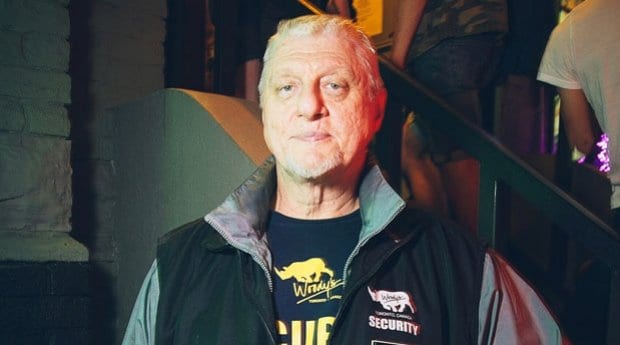You’ve met Big Bob. That is to say, if you’ve been to Woody’s in the past decade or so (and of course you have), chances are he was the one checking your ID on the way in or kindly escorting you from the premises on your way out. For many queers new to Toronto, Woody’s is the gateway to the entire LGBT scene, and that makes Bob the gatekeeper. As part of our coverage of Woody’s 25th anniversary, we asked Bob to share his thoughts on the changing face of Church Street and some of his most memorable nights working the door.
Xtra: So, how long have you been working at Woody’s?
Big Bob: I have been at Woody’s since 2003 and have been working security there during that time. I have enjoyed it very much, and I’ve come to know an awful lot of people. The ownership here has always been great. It’s a good family, a good place to work and a good place to drink and be entertained.
What were you up to before you started at Woody’s?
I’ve worked in the gay community for almost 40 years. I was at Remington’s for 10 years. And before that, I had worked at Colby’s and Chaps, and before that I worked at Club Manatee. So, I’d been at a lot of places over the years.
You must have seen some big changes in the neighbourhood over the years.
Very much so. The whole scene has moved from the Yonge and Bloor area to Church Street. The bar scene has probably diminished somewhat because of everything that’s evolved with technology. When smoking became illegal in the bars, it really changed the whole dynamic. And the main thing I find now is that there’s really no after-hours place in the gay scene. There used to be so much, you know? There used to be three or four places where you could go when the bars closed. You could go and dance or hang out, but there’s really nothing like that anymore.
Do you think Woody’s still holds its place as a tent pole for the community?
When people are new in town, they come to Woody’s. That’s where you hang out. That’s where you meet people; that’s where you get your feet wet in the gay community, as it were. It’s very well known. And we get people from all over the world on any given night. If they’re new in town and they wanna see what’s happening, Woody’s is probably the first place they come to.
And do they stick around, or do they tend to move on?
Well, you see different waves of young people. They come and you’ll see them for a period of three to five years, and then you’ll kind of get a new wave and you’ll see different people. They get older or have relationships and you see them less. And then you get to see a new crop. But Woody’s itself has remained very calm and very stable. Maybe the décor has changed and some of the personnel has changed, that’s all.
What are some of the most memorable nights you’ve worked?
There’s a lot of history. I remember quite vividly that we had a ceremony of remembrance for [Toronto gay activist] George Hislop when he died. And Jack Layton and Olivia Chow were there, of course. And I believe John Tory was as well. I’ve seen him at Woody’s many times. There were a lot of notable people there that afternoon. George was an important part of our community.
And what about the parties?
There was our 20th anniversary; I remember that very well. That was a really wild night. We were very, very busy. We had a lineup over to Maitland and beyond. And then there was the time we had the release party for Madonna’s Confessions on a Dance Floor. And that was a really mad night, because the people from the record company had a big stretch limo all painted up like Madonna with all this about her release, and they parked in front. There was a big lineup, and everyone thought that Madonna was either at Woody’s or coming for this CD release. As long as that big limo was outside, you couldn’t move; it was crazy. Of course, Madonna was never there. She was never going to be there, but people never realized. Rumours, you know. That’s the way it goes.

 Why you can trust Xtra
Why you can trust Xtra


